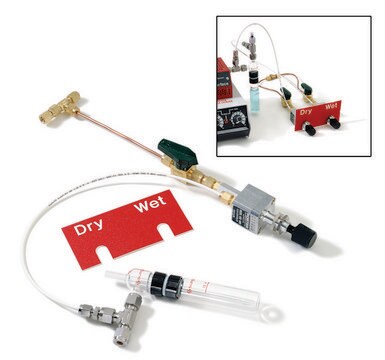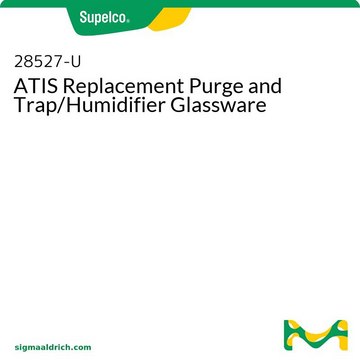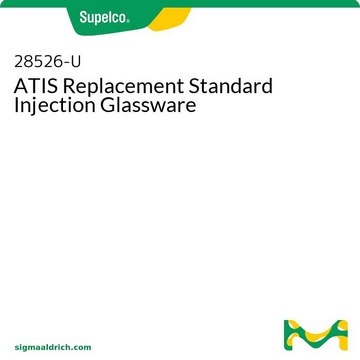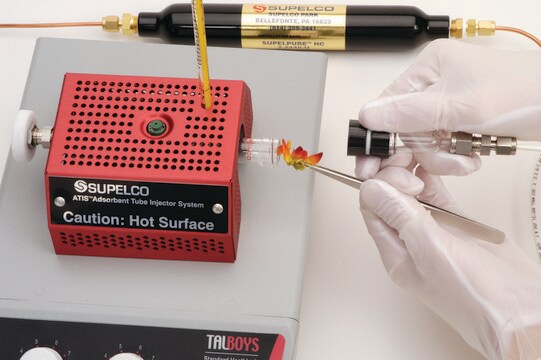29735-U
SLB®-1ms Capillary GC Column
L × I.D. 15 m × 0.32 mm, df 0.25 μm
Sign Into View Organizational & Contract Pricing
All Photos(1)
About This Item
UNSPSC Code:
41115710
NACRES:
SB.54
Recommended Products
material
fused silica
Quality Level
Agency
meets requirements for USP G1, G2 and G9
parameter
-60-340 °C temperature (isothermal)
-60-360 °C temperature (programmed)
Beta value
320
df
0.25 μm
technique(s)
GC/MS: suitable
gas chromatography (GC): suitable
L × I.D.
15 m × 0.32 mm
matrix active group
Bonded and crosslinked; poly(dimethyl siloxane) phase
application(s)
petroleum
column type
capillary non-polar
Looking for similar products? Visit Product Comparison Guide
General description
Application: The non-polar dimethyl phase provides a boiling point elution order. The low bleed characteristics, inertness, and durable nature make it the column of choice for many petrochemical appplications, or anywhere a low bleed non-polar column is required.
USP Code: This column meets USP G1, G2, and G9 requirements.
Phase:
USP Code: This column meets USP G1, G2, and G9 requirements.
Phase:
- Bonded and crosslinked
- Poly(dimethyl siloxane)
- -60 °C to 340 °C (isothermal) or 360 °C (programmed)
Legal Information
SLB is a registered trademark of Merck KGaA, Darmstadt, Germany
Choose from one of the most recent versions:
Already Own This Product?
Find documentation for the products that you have recently purchased in the Document Library.
Ryugo Tero et al.
Langmuir : the ACS journal of surfaces and colloids, 27(16), 9662-9665 (2011-07-19)
Hierarchic structure and anomalous diffusion on submicrometer scale were introduced into an artificial cell membrane, and the spatiotemporal dependence of lipid diffusion was visualized on nanostructured oxide surfaces. We observed the lipid diffusion in supported lipid bilayers (SLBs) on step-and-terrace
P Vahmani et al.
Lipids, 51(12), 1427-1433 (2016-11-18)
Human liver cells (HepG2) were cultured with individual trans (t) 18:1 including t6-, t12-, t13-, t14-, t15- and t16-18:1, and retention times of their Δ-9 desaturation products were determined using 100-m biscyanopropyl-polysiloxane and SLB-IL111 columns. Corresponding peaks were found in
Martin D Hürlimann et al.
Journal of colloid and interface science, 297(1), 303-311 (2005-11-23)
We present new NMR techniques to characterize food products that are based on the measurement of two-dimensional diffusion-T2 relaxation and T1-T2 relaxation distribution functions. These measurements can be performed in magnets of modest strength and low homogeneity and do not
Single giant vesicle rupture events reveal multiple mechanisms of glass-supported bilayer formation.
Chiho Hamai et al.
Biophysical journal, 92(6), 1988-1999 (2006-12-26)
The formation of supported lipid bilayers (SLBs) on glass from giant unilamellar vesicles (GUVs) was studied using fluorescence microscopy. We show that GUV rupture occurs by at least four mechanisms, including 1), spontaneous rupture of isolated GUVs yielding almost heart-shaped
Qun Zhang et al.
Se pu = Chinese journal of chromatography, 32(8), 886-889 (2014-12-02)
An analytical method was established for the determination of propargite, tebuconazole and bromopropylate in Taiwan green jujubes (Zizyphus mauritiana Lam) by gas chromatography-tandem mass spectrometry (GC-MS/MS). The sample was extracted with acetonitrile from the Taiwan green jujubes after treated with
Our team of scientists has experience in all areas of research including Life Science, Material Science, Chemical Synthesis, Chromatography, Analytical and many others.
Contact Technical Service







